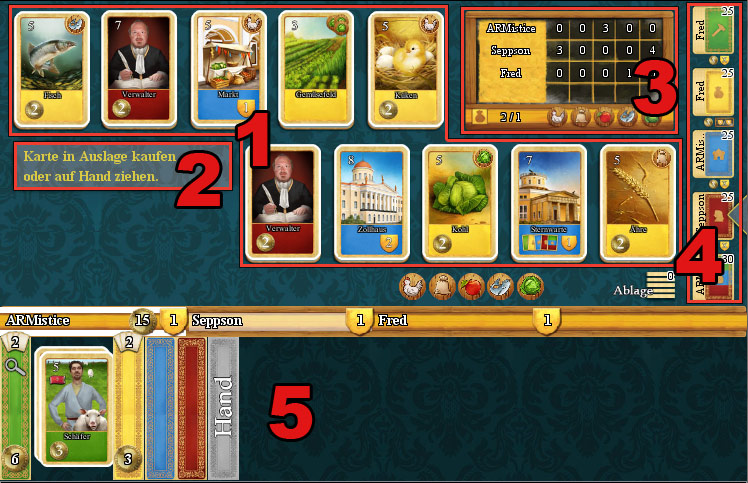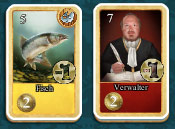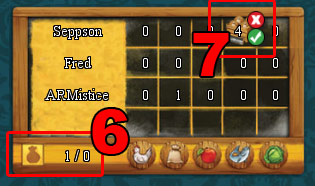Sankt Petersburg
Preparation of the game
Use the command /join of 2-4 players can play the game. Use the command /start to play the game. Tambien puede usar la Herramienta de Juego!
Objetivo del juego

Saint Petersburg is a game characterized by scarce capital. The players buy craftsmen, buildings, nobles or market cards in order to score as many victory points as possible. This is done on a turn-based basis: after the craftsman phase (green) only these are scored, after the market phase (yellow) the market is scored, after the building phase (blue) only buildings are scored and after the nobles phase (orange) there is a scoring for nobles. The 5th phase, superstructure cards (mixed), does not result in any scoring.

You can see which player's turn it is based on the white background in the lower area (5). and whose display you are currently looking at. The display on the right edge (4) always shows who the starting player is in which phase of the game. You can use the arrow to see which phase of the game you are currently in. The number of cards in the draw piles is shown at the top right.
Las cartas
< p> El dinero que reporta cada carta en su fase correspondiente se indica con un símbolo de rublo en la parte de abajo a la izquierda de la carta; Los puntos de Victoria, with an escudo amarillo abajo a la derecha.Artesano (Craftsman)

Estas Cartas reportan principalmente dinero. The price of the carta card must be in the superior price. Abajo se muestra el ingreso (en este caso 3 rublos) que generará el artesano in su face de puntuación (verde). The artesanos pose in a symbol in the upper part of the tree, which is indicative of the type. The tip of a tractor is important for the cards of evolution (very large).
Mercado < /h4> 
These cards bring an increase in market value in the 5 categories. The number and market category is visible on the map at the top right. At the bottom, the "1" shows the income per round (yellow rating), as with the other cards.
Edificios< /span>

Estas cartas generan principalmente puntos de Victoria. This means that the price in the table is superior. The puntos de Victoria por Ronda (fase de puntuación azul) se indican abajo a la derecha en un escudo amarillo.
Nobles

Estas cartas reportan menos rublos que los artesanos que los artesanos y menos puntos de Victoria que los edificios, pero son muy interesantes para la puntuación final (ver más abajo).
Cartas de evolución

Estas cartas se caracterizan por tener A cuadro alrededor of the price of the carta. Hay cards de evolution para cada categoría (artesanos, edificios y nobles). It can be constructed uniquely using a carta propia del mismo color que ya esté en la mesa. In this case there is always a difference in price with the card between the two items (como minimo un rublo). The cards of green evolution are only written in the same way as the artists with the same symbol.
Desarrollo del juego
Al principio del juego se descubren sobre la mesa 2 cartas de artesanos disponibles por cada jugador (las cartas disponibles para ser compradas aparecen en la parte superior de la pantalla). The player can have 25 rubles as the initial capital and is recommended to be compared with 2 items lasting the first time in green. Para llevar a cabo una compra, arrastra la carta deseada a tu área de game (en la que pone tu nombre); se restará the price of the carta de tu dinero. If you don't want to compare more cards, you can click on the symbol of the phase corresponding to the panel that arrives in the derecha.
Se pueden tener hasta 3 cards en la mano para comprarlas posteriormente. Para llevar una carta available a tu mano símplemente arrastra the carta elegida al símbolo de la mano all lado de tu nombre en tu área de game. If you want to have a carta de tu mano in tu área de game (comprarla), butre la ventanita de las cartas de mano haciendo click en el símbolo correspondiente (si no está abierta ya), y arrastra la carta deseada tu área de game as the costume; The price is worth restará de tu dinero. ¡Cuidado: the cards are permanent in the final part of the party restan 5 points in Victoria in one place!
Todas las cards available en la You can compare the hand in the right moment, independent of the phase in which it is located and the type of the card. For example, it is possible to construct buildings in the phase of the nobles.
Pur tanto hay 4 actions basics that can be realized:
1. Comprar a card available and ponerla in tu area de game.
2. Tomar una de las cards available y llevarla a tu mano (en caso de que tengas espacio suficiente).
3. Comprar una carta de tu mano y colocarla en tu área de game.
4. Pasar.
Una vez que han pasado todos los jugadores consecutivamente, se pasa a la siguiente phase y se rellena with the mazo correspondiente el número de cartas available sobre la mesa hasta 8 ( si, por ejemplo, después de la fase de artesanos quedaron 5 cartas sobre la mesa, se añadirán 3 edificios). En cada phase the jugador initial is distinct. The small symbols according to the name of the player in the area of the game are indican that they can be played at the same time. The symbols must be placed in the sentido de las agujas del reloj.
Al final de cada phase (excepto en la phase de evolution) is lleva a cabo una puntuación :
- al final de la fase de artesanos (cuando todo el mundo ha pasado) cada jugador recibe la suma correspondiente de rublos y los puntos de Victoria por cada carta verde de su área de juego.
- At the end of the market phase each player receives a yellow card for each card on display corresponding rubles. In addition, the majority (and second place) in the individual market categories will be rewarded with points Las cards azules de su área de juego.
- al final de la fase de nobles cada jugador recibe los rublos y los puntos de Victoria correspondientes a las cards naranjas de su área de game.
- al final de la fase de evolution no se puntúa.
Compras rebajadas
Si compras una carta igual a otra(s) que ya tienes en tu área de juego puedes ahorrar rublos. Por cada carta igual se ahorra un rublo. The embargo on the minimum cost is 1 rublo. (Ejemplo: if you have two mercados built and sold, it costs 3 rublos)

At the end of each round (i.e. after the 5th phase) everyone doesn't get anything Purchased cards on top receive a -1. They are one ruble cheaper in the next round. Cards that already had a -1 are removed from the game at the end of the round.
Market phase
At the end of the yellow market phase, the majorities in the individual market categories are counted. 1st and 2nd place will be determined in the chicken, grain, apple, fish and cabbage categories. You get more points every round as the game progresses. (1st round 1/0, 2nd round 2/1, 3rd round 3/1, 4th round 4/2 etc.) The number of points you get for first and second place is shown at the bottom left (6).

However, each box in a category must be confirmed before the yellow rating. (7) Confirmation means: The player must pay the higher of the current market value (6) in rubles. (In this example only 1 ruble)
Fin de la partida
If the principle of the cualquier phase is not complete, the number of the cards available is 8, and the cards in the robot correspondent, you will have the final round of the 4th phase and the part will be acabado.
Entonces se consigue 1 point de Victoria por cada 10 rublos que no se hayan gastado. Por cada carta quede en la mano se puntúa -5.
Además se hará una puntuación final por los nobles distintos en el área de game. There are 2 nobles distintos in sumarán 1+2=3 points de Victoria extra; si son 5, se sumarán 1+2+3+4+5=15; etc., as indicated in the table:
| X | 1 | 2 | 3 | 4 | 5 | 6 | 7 | 8 | 9 | 10 |
| Points of Victoria | 1 | 3 | 6 | 10 | 15 | 21 | 28 | 36 | < td>4555 |
Se tienen en cuenta como máximo 10 nobles differentes (55 puntos como máximo). < /p>
Cartas especiales
Algunas cartas have special functions, which are explained in a continuation:

El zar Peter is an evolutionary conduit with the carta de evolution verde.

La orfebrería (which is constructed sobre el buscador de oro) reduces the price of compra de cada noble en un rublo.

The carpintería (evolución del leñador) modifica el precio de cada edificio con un -1.

In the blue scoring, the player receives one victory point for each of his nobles on display.

El jugador paga 2 rublos cuando construct the carta. They subsequently constructed a carta de evolución sobre ella, su valor cuenta como 6.

El pub permite, Just after the blue point, compare a point from Victoria for 2 rublos (as a maximum of 5 points from Victoria for Ronda and for the pub). Verás el símbolo correspondiente arriba a la derecha en esta phase. Utiliza las flechas para seleccionar la cantidad que quieres gastar y a continuación pulsa "OK".

El poseedor de un Almacén puede tener hasta 4 cards en la mano. If you construct a card of evolution sobre él, you can get 4 cards in the hand that you have to compre/construct a de ellas; entonces el límite volverá a ser de 3.


The observatory normally brings one victory point. However, it can be "turned" in the blue phase, but the victory point is then lost for this round. Instead, you can draw a card from any stack (but not the last one) and then build it, put it into your hand or discard it. In order to make this possibility visible, the observatory function is displayed in the action area (2). You can then draw directly from the corresponding stack on the right side.

El cobrador de impuestos genera en la Puntuación naranja tantos rublos como artesanos se tengan en área de game.
Variation in solitario - SU
San Petersburgo también Se puede jugar en solitario. The rules are identical. Simple one part and initial como de costumbre. The object of the part is conseguir tantos puntos como sea posible.

